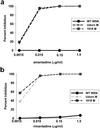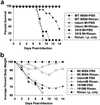Existing antivirals are effective against influenza viruses with genes from the 1918 pandemic virus - PubMed (original) (raw)
Existing antivirals are effective against influenza viruses with genes from the 1918 pandemic virus
Terrence M Tumpey et al. Proc Natl Acad Sci U S A. 2002.
Abstract
The 1918 influenza pandemic caused more than 20 million deaths worldwide. Thus, the potential impact of a re-emergent 1918 or 1918-like influenza virus, whether through natural means or as a result of bioterrorism, is of significant concern. The genetic determinants of the virulence of the 1918 virus have not been defined yet, nor have specific clinical prophylaxis and/or treatment interventions that would be effective against a re-emergent 1918 or 1918-like virus been identified. Based on the reported nucleotide sequences, we have reconstructed the hemagglutinin (HA), neuraminidase (NA), and matrix (M) genes of the 1918 virus. Under biosafety level 3 (agricultural) conditions, we have generated recombinant influenza viruses bearing the 1918 HA, NA, or M segments. Strikingly, recombinant viruses possessing both the 1918 HA and 1918 NA were virulent in mice. In contrast, a control virus with the HA and NA from a more recent human isolate was unable to kill mice at any dose tested. The recombinant viruses were also tested for their sensitivity to U.S. Food and Drug Administration-approved antiinfluenza virus drugs in vitro and in vivo. Recombinant viruses possessing the 1918 NA or both the 1918 HA and 1918 NA were inhibited effectively in both tissue culture and mice by the NA inhibitors, zanamivir and oseltamivir. A recombinant virus possessing the 1918 M segment was inhibited effectively both in tissue culture and in vivo by the M2 ion-channel inhibitors amantadine and rimantadine. These data suggest that current antiviral strategies would be effective in curbing the dangers of a re-emergent 1918 or 1918-like virus.
Figures
Figure 1
Inhibition in vitro of the 1918 influenza virus NA by zanamivir and GS4071 (oseltamivir carboxylate). Extracts expressing WSN NA, New Caledonia NA, or 1918 NA were assayed in the presence of the indicated concentrations of zanamivir (a) or GS4071 (oseltamivir carboxylate) (b). Activities are given as percent activity relative to the no-drug control.
Figure 2
Oseltamivir effectively inhibits replication in tissue culture of recombinant influenza viruses possessing the 1918 NA and prevents lethal infection in mice of the recombinant 1918 HA/1918 NA influenza virus. (a) Inhibition of plaque formation by GS4071 (oseltamivir carboxylate). Plaque-reduction assays were performed on MDCK cells by using the indicated concentrations of drug following established methods (29). (b) Oral administration of oseltamivir protects mice from death due to intranasal infection with the 1918 HA/1918 NA virus. Indicated is the percentage of mice surviving intranasal infection at the indicated times postinfection.
Figure 3
Inhibition of virus plaque formation by amantadine and rimantadine. (a) Percent inhibition of plaque formation in the presence of the indicated concentrations of amantadine hydrochloride. (b) Percent inhibition of plaque formation in the presence of the indicated concentrations of rimantadine hydrochloride. Recombinant, wild-type (WT) WSN virus (circles), Udorn M virus (triangles), and 1918 M virus (squares) were tested for their ability to form plaques in the presence of the indicated concentrations of drug. The data are reported as the percent inhibition of plaque formation as compared with a no-drug control for each virus.
Figure 4
Rimantadine protects mice from lethal infection with an influenza virus possessing the 1918 M segment. (a) Survival after infection with the indicated viruses and either mock treatment with PBS or treatment with rimantadine. An uninfected but treated control group was included also. (b) Average weight of mice from the same groups as in a. Average weight is reported for all mice surviving at the indicated time points. Groups of 8 or 9 mice were infected with 10 LD50 of wild-type (WT) WSN virus (circles) or 1918 M virus (squares) or with 106 pfu of Udorn M virus (1 LD80, triangles). The mice then were mock-treated with PBS (filled symbols) or treated with 40 mg/kg of body weight of rimantadine hydrochloride (open symbols). PBS or drug was administered i.p. beginning 6 h postinfection and once daily afterward. One group of mice was left uninfected and treated with rimantadine (filled diamonds).
Similar articles
- Global host immune response: pathogenesis and transcriptional profiling of type A influenza viruses expressing the hemagglutinin and neuraminidase genes from the 1918 pandemic virus.
Kash JC, Basler CF, García-Sastre A, Carter V, Billharz R, Swayne DE, Przygodzki RM, Taubenberger JK, Katze MG, Tumpey TM. Kash JC, et al. J Virol. 2004 Sep;78(17):9499-511. doi: 10.1128/JVI.78.17.9499-9511.2004. J Virol. 2004. PMID: 15308742 Free PMC article. - Utilization of the embryonated egg for in vivo evaluation of the anti-influenza virus activity of neuraminidase inhibitors.
Sauerbrei A, Haertl A, Brandstaedt A, Schmidtke M, Wutzler P. Sauerbrei A, et al. Med Microbiol Immunol. 2006 Jun;195(2):65-71. doi: 10.1007/s00430-005-0002-x. Epub 2005 Jul 30. Med Microbiol Immunol. 2006. PMID: 16059699 - Increased adamantane resistance in influenza A(H3) viruses in Australia and neighbouring countries in 2005.
Barr IG, Hurt AC, Iannello P, Tomasov C, Deed N, Komadina N. Barr IG, et al. Antiviral Res. 2007 Feb;73(2):112-7. doi: 10.1016/j.antiviral.2006.08.002. Epub 2006 Aug 28. Antiviral Res. 2007. PMID: 16963130 - Antivirals--current trends in fighting influenza.
Król E, Rychłowska M, Szewczyk B. Król E, et al. Acta Biochim Pol. 2014;61(3):495-504. Epub 2014 Sep 1. Acta Biochim Pol. 2014. PMID: 25180220 Review. - Integrating historical, clinical and molecular genetic data in order to explain the origin and virulence of the 1918 Spanish influenza virus.
Taubenberger JK, Reid AH, Janczewski TA, Fanning TG. Taubenberger JK, et al. Philos Trans R Soc Lond B Biol Sci. 2001 Dec 29;356(1416):1829-39. doi: 10.1098/rstb.2001.1020. Philos Trans R Soc Lond B Biol Sci. 2001. PMID: 11779381 Free PMC article. Review.
Cited by
- Oseltamivir Is Effective against 1918 Influenza Virus Infection of Macaques but Vulnerable to Escape.
Feldmann F, Kobasa D, Embury-Hyatt C, Grolla A, Taylor T, Kiso M, Kakugawa S, Gren J, Jones SM, Kawaoka Y, Feldmann H. Feldmann F, et al. mBio. 2019 Oct 22;10(5):e02059-19. doi: 10.1128/mBio.02059-19. mBio. 2019. PMID: 31641086 Free PMC article. - Effectiveness and cost-effectiveness of expanded antiviral prophylaxis and adjuvanted vaccination strategies for an influenza A (H5N1) pandemic.
Khazeni N, Hutton DW, Garber AM, Owens DK. Khazeni N, et al. Ann Intern Med. 2009 Dec 15;151(12):840-53. doi: 10.7326/0003-4819-151-12-200912150-00156. Ann Intern Med. 2009. PMID: 20008760 Free PMC article. - A single amino acid substitution in 1918 influenza virus hemagglutinin changes receptor binding specificity.
Glaser L, Stevens J, Zamarin D, Wilson IA, García-Sastre A, Tumpey TM, Basler CF, Taubenberger JK, Palese P. Glaser L, et al. J Virol. 2005 Sep;79(17):11533-6. doi: 10.1128/JVI.79.17.11533-11536.2005. J Virol. 2005. PMID: 16103207 Free PMC article. - Antiviral agents active against influenza A viruses.
De Clercq E. De Clercq E. Nat Rev Drug Discov. 2006 Dec;5(12):1015-25. doi: 10.1038/nrd2175. Nat Rev Drug Discov. 2006. PMID: 17139286 Free PMC article. Review. - Identification, Genetic Analysis, and Pathogenicity of Classical Swine H1N1 and Human-Swine Reassortant H1N1 Influenza Viruses from Pigs in China.
Song Y, Zhang Y, Zhang B, Chen L, Zhang M, Wang J, Jiang Y, Yang C, Jiang T. Song Y, et al. Viruses. 2020 Jan 2;12(1):55. doi: 10.3390/v12010055. Viruses. 2020. PMID: 31906591 Free PMC article.
References
- Reid A H, Taubenberger J K, Fanning T G. Microbes Infect. 2001;3:81–87. - PubMed
- Kilbourne E D. The Influenza Viruses. New York: Academic; 1975. pp. 483–538.
- U.S. Department of Commerce. Historical Statistics in the United States: Colonial Times to 1970. Washington, DC: U.S. Government Printing Office; 1976. p. 58.
- Crosby A. America's Forgotten Pandemic. Cambridge, U.K.: Cambridge Univ. Press; 1989.
- Winternitz M C, Wason I M, McNamara F P. Pathology of Influenza. New Haven, CT: Yale Univ. Press; 1920.
Publication types
MeSH terms
Substances
LinkOut - more resources
Full Text Sources
Other Literature Sources
Medical



